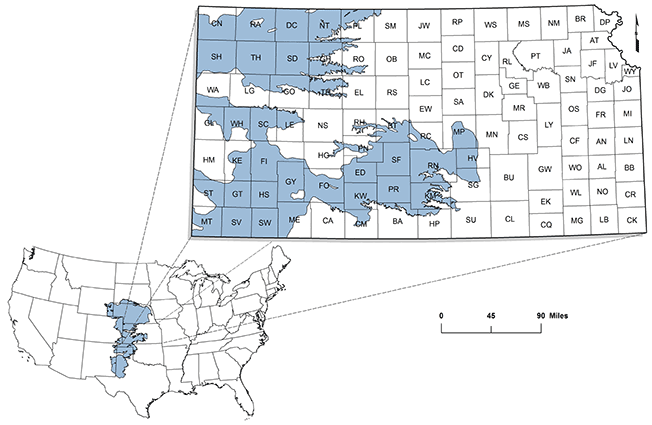The Ogallala Aquifer (technically the High Plains Aquifer) underlies an area in eight states, of approximately 174,000 sq mi, being one of the world’s largest aquifers. 30,800 square miles of that is in western and central Kansas, 900 sq mi in Colorado, 20,600 sq mi in Texas, and it is under virtually all of the state of Nebraska. The aquifer stores as much water volume as Lake Huron (2.9 billion acre-feet). It provides 30 percent of the United States’ irrigation, contributing to an astounding 20 percent of the country’s entire agricultural output. The Ogallala water accumulated slowly over tens of thousands of years, and aquifer recharge occurs very slowly because of scant rainfall on the high plains. In most of the aquifer, except for Nebraska, the irrigation use by high water-demand crops like corn is far greater than the recharge rate. In Colorado alone, farmers pumped water out of 4,000 wells, sucking out as much as 500 gallons per minute per well.

In western Kansas, farmers are drawing down their region’s groundwater at more than six times the natural rate of recharge. Kansas State University researchers found that 30 percent of the region’s groundwater has been tapped out. As underground water levels drop, pumping from a greater depth becomes more and more expensive, to the point of unprofitability. The advent of center-pivot irrigation systems in the 1960’s allowed people to irrigate uneven terrain, which opened up large new areas for water thirsty crops like corn. That led, in turn, to large feedlots and packing plants. The combination of corn for cattle feed, and corn for government subsidized ethanol production has driven a tripling of the price of corn since 2002, and Kansas farmers have responded by increasing the acreage of irrigated cornfields by nearly a fifth. This price bubble will burst when the Ogalla Aquifer drops so deep that pumping costs will become prohibitive. By then, the midwest will have become the Great American Desert. Learn more at – The real reason Kansas is running out of water, and Why These 8 States Could Soon Form the ‘Great American Desert’.


Recent Comments